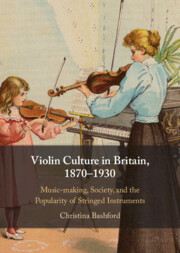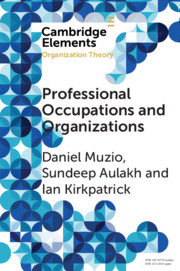Refine search
Actions for selected content:
37 results
Revolutionising mental health in Africa: bridging gaps and breaking down barriers
- Part of
-
- Journal:
- BJPsych International , FirstView
- Published online by Cambridge University Press:
- 28 October 2025, pp. 1-4
-
- Article
-
- You have access
- Open access
- HTML
- Export citation

Violin Culture in Britain, 1870–1930
- Music-making, Society, and the Popularity of Stringed Instruments
-
- Published online:
- 13 September 2025
- Print publication:
- 18 September 2025
4 - A State-of-the-Art All-Black Hospital
-
- Book:
- A Black Army
- Published online:
- 16 June 2025
- Print publication:
- 17 July 2025, pp 77-98
-
- Chapter
- Export citation
Chapter 11 - Having Someone in Your Corner
-
- Book:
- Young People with Cognitive Disability in Transition to Adulthood
- Published online:
- 06 February 2025
- Print publication:
- 13 February 2025, pp 209-221
-
- Chapter
- Export citation
2 - Empire Apart, Empire Together
-
- Book:
- Geographies of Gender
- Published online:
- 09 January 2025
- Print publication:
- 23 January 2025, pp 77-114
-
- Chapter
- Export citation
Professional’s Views on the ‘Nordic Paradox’ in a Low Intimate Partner Violence Prevalence Country
-
- Journal:
- The Spanish Journal of Psychology / Volume 27 / 2024
- Published online by Cambridge University Press:
- 17 May 2024, e13
-
- Article
-
- You have access
- Open access
- HTML
- Export citation
4 - Outsourcing Democracy through Professional Consulting
-
- Book:
- The New Experts
- Published online:
- 09 May 2024
- Print publication:
- 16 May 2024, pp 94-132
-
- Chapter
- Export citation
19 - Being a Good Partner
-
- Book:
- How to Talk Language Science with Everybody
- Published online:
- 17 May 2023
- Print publication:
- 29 June 2023, pp 231-241
-
- Chapter
- Export citation
Chapter 13 - Reducing Substance Use Stigma in Health Care
-
-
- Book:
- The Stigma of Substance Use Disorders
- Published online:
- 23 June 2022
- Print publication:
- 09 June 2022, pp 232-251
-
- Chapter
- Export citation
Have the Welfare Professions Lost Autonomy? A Comparative Study of Doctors and Teachers
-
- Journal:
- Journal of Social Policy / Volume 53 / Issue 1 / January 2024
- Published online by Cambridge University Press:
- 11 April 2022, pp. 64-85
- Print publication:
- January 2024
-
- Article
-
- You have access
- Open access
- HTML
- Export citation
7 - Global Governance, Expert Networks, and “Fragile States”
-
-
- Book:
- Global Governance in a World of Change
- Published online:
- 02 December 2021
- Print publication:
- 09 December 2021, pp 214-233
-
- Chapter
-
- You have access
- Open access
- HTML
- Export citation
Facing the COVID-19: A qualitative research on the impact of the pandemic on autism spectrum disorder (ASD)
-
- Journal:
- European Psychiatry / Volume 64 / Issue S1 / April 2021
- Published online by Cambridge University Press:
- 13 August 2021, p. S289
-
- Article
-
- You have access
- Open access
- Export citation
Chapter 3 - Dimension II: Levels of Creativity
- from Part II - Elaborating the Theoretical Model
-
- Book:
- Constraints and Creativity
- Published online:
- 09 July 2021
- Print publication:
- 29 July 2021, pp 85-124
-
- Chapter
- Export citation
Business Co-operatives in Australia: “Unlikely Soil for a Co-operative Movement”
-
- Journal:
- Enterprise & Society / Volume 24 / Issue 1 / March 2023
- Published online by Cambridge University Press:
- 05 July 2021, pp. 149-173
- Print publication:
- March 2023
-
- Article
- Export citation
Chapter 1 - What is a teacher?
- from Part 1 - Introduction to education
-
-
- Book:
- Introduction to Education
- Published online:
- 13 February 2021
- Print publication:
- 22 January 2021, pp 2-30
-
- Chapter
- Export citation
Mobile Professionals and Metropolitan Models: The German Roots of Vocational Education in Latin America
-
- Journal:
- European Journal of Sociology / Archives Européennes de Sociologie / Volume 61 / Issue 2 / August 2020
- Published online by Cambridge University Press:
- 01 July 2020, pp. 185-218
-
- Article
- Export citation
Community mental health services in the eyes of community mental health centers staff
-
- Journal:
- European Psychiatry / Volume 41 / Issue S1 / April 2017
- Published online by Cambridge University Press:
- 23 March 2020, p. S602
-
- Article
-
- You have access
- Export citation

Professional Occupations and Organizations
-
- Published online:
- 20 December 2019
- Print publication:
- 16 January 2020
-
- Element
- Export citation
5 - The Contested Rise of Astrometeorology
-
- Book:
- Medieval Meteorology
- Published online:
- 08 November 2019
- Print publication:
- 21 November 2019, pp 110-133
-
- Chapter
- Export citation
Meaning of work and personal protective factors among palliative care professionals
-
- Journal:
- Palliative & Supportive Care / Volume 17 / Issue 4 / August 2019
- Published online by Cambridge University Press:
- 07 March 2019, pp. 381-387
-
- Article
- Export citation
